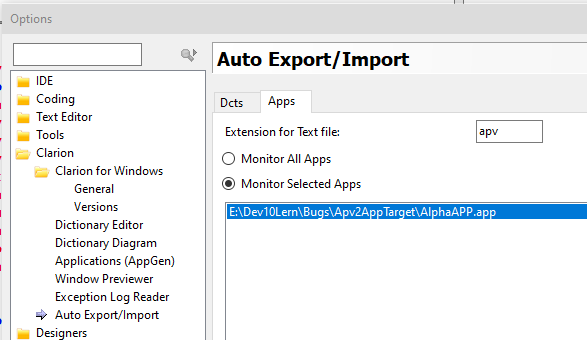Your wish is granted.
Under Options – Clarion – Auto Export/Import: you can set the IDE to also save APP as APV which is a TXA format, and DCT as DCV in DCTX format. The APV/DCV are the primary file so at load time the APP is ignored and built from the APV … or maybe it does a date compare and only makes the APP if it appears older than the APV.
This means your APP cannot have TXA issues like a Square bracket in column 1 of embed code. One export / import TXA and compare CLWs will tell you.
The Feb 2019 Clarion 11.13371 release made it possible to configure this with a file in the folder so each developer did not need to config their IDE. I think this may work in older releases.
FEATURE: Adding a .dct.BinaryImport file into a directory will turn on automatic import/export for dct files. Similarly the existence of a .app.BinaryImport file will turn on import/export of app files. This file can be empty or contain multiple lines with each line being a file pattern to match files. If the file is empty, then all dct/app files will be imported/exported. Otherwise only files that match at least one of the file patterns will be imported/exported.
Do full APP TXA’s work well for Source Control is a separate question. Unless PRIORY is made unique in the TPLs the code can jump around. It can be ugly to understand TXA format changes. I would also check in generated CLWs. When I last did this we decided to always replace the full APV and not try to store deltas. I think that was with Source Gear.
There are some other posts here. Search for APV or Source Control or Version Control.
Donn if you can work like Kevin describes where you agree that only one person works on an APP this can work, at least to get started. Rick’s way is the best for multiple active devs.
